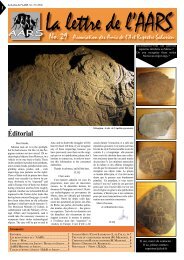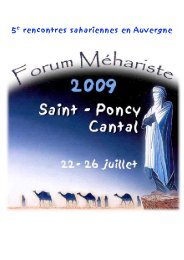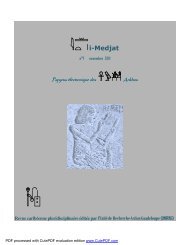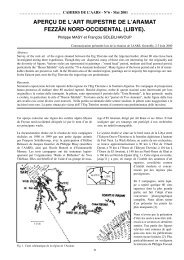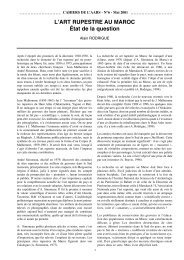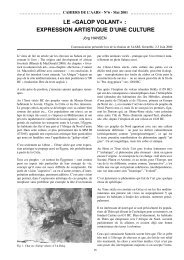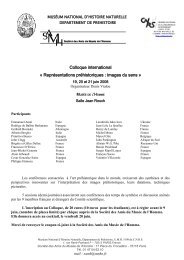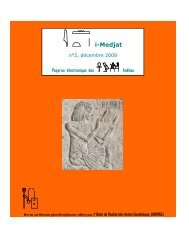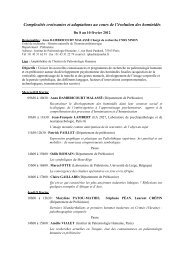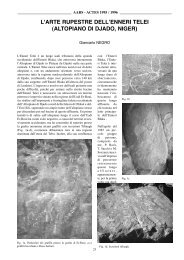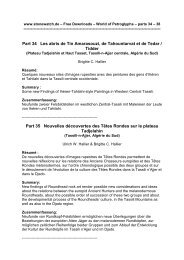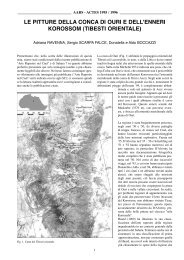From the Sahara to the Nile - Amis de l'Art rupestre saharien (AARS)
From the Sahara to the Nile - Amis de l'Art rupestre saharien (AARS)
From the Sahara to the Nile - Amis de l'Art rupestre saharien (AARS)
Create successful ePaper yourself
Turn your PDF publications into a flip-book with our unique Google optimized e-Paper software.
3.2. The Hyena<br />
The striped hyena (Hyaena hyaena, Linnaeus<br />
1758)<br />
The remains of <strong>the</strong> striped hyena, dating from<br />
4800 – 3750 BC have been found in <strong>the</strong> Libyan<br />
<strong>de</strong>sert (Peters 1988: 75). The presence of this<br />
animal during <strong>the</strong> period of <strong>the</strong> engravers has been<br />
confirmed <strong>to</strong> <strong>the</strong> North East of a line from Siwa <strong>to</strong><br />
Abu Simbel (Wendorf & Schild 2001: 620),<br />
without <strong>the</strong>re being any representation in <strong>the</strong> rock<br />
art <strong>to</strong> our knowledge. The striped hyena<br />
occasionally attacks cattle (Kruuk 2005:86; Mills<br />
& Hofer 1998: 23-4), and human beings, notably<br />
children (Mills & Hofer 1998: 87; Nowak et al<br />
2005: 226). These are dangerous animals.<br />
3.3. The dogs<br />
The African Wild Dog (Lycaon pictus,<br />
Temminck 1820)<br />
The African Wild Dog which subsists in <strong>the</strong><br />
central <strong>Sahara</strong> (Bur<strong>to</strong>n & Bur<strong>to</strong>n 1973: 2752; Le<br />
Quellec 1998: 352), probably co-existed with <strong>the</strong><br />
artists of <strong>the</strong> Libyan <strong>de</strong>sert. Mason and Szechenyi<br />
have indicated <strong>the</strong>ir presence in Wadi Howar.<br />
They also had a wi<strong>de</strong>spread presence in Egypt.<br />
But elsewhere, according <strong>to</strong> <strong>the</strong> archaeozoologist<br />
Achille Gautier, <strong>the</strong> absence of a species which<br />
was not normally part of <strong>the</strong> prehis<strong>to</strong>ric diet is<br />
hardly surprising (1993: 262-4). The apparent<br />
ferocity of this animal, which <strong>the</strong>se days does not<br />
attack man, perhaps explains why it is not<br />
represented: "The spectacle of a pack of wild dogs<br />
tearing at a live animal still on its feet is dreadful<br />
and without doubt one of <strong>the</strong> most impressive<br />
sights on <strong>the</strong> plains of Africa. And when we are on<br />
hand at a tragedy of this sort, we<br />
would not be greatly surprised if<br />
<strong>the</strong>se carnivores are consi<strong>de</strong>red<br />
<strong>the</strong> most cruel" (La Faune 13:<br />
250).<br />
But elsewhere, <strong>the</strong> East<br />
Africans have an eloquent saying<br />
about <strong>the</strong> dog which is, "<strong>the</strong><br />
running <strong>de</strong>ath on <strong>the</strong> plains" (Le<br />
Quellec 1998: 356). The wild<br />
dog is strong enough <strong>to</strong> take on<br />
<strong>the</strong> very large antelopes, also<br />
giraffes and even lions, in<br />
isolation (Bur<strong>to</strong>n & Bur<strong>to</strong>n<br />
1973: 2752). The end is so<br />
dreadful that <strong>the</strong>y are feared as<br />
much as large cats, such as <strong>the</strong><br />
pan<strong>the</strong>r (Le Quellec 1998: 357).<br />
It is this terrible ferocity<br />
which makes <strong>the</strong>m appear such a<br />
menace <strong>to</strong> <strong>the</strong> inhabitants of <strong>the</strong><br />
<strong>de</strong>sert. One engraving in Wadi<br />
Fig. 4. A painting from<br />
Karkur Talh (Jebel<br />
Uweinat) shows a group<br />
of archers, with arrows in<br />
abundance hanging from<br />
a cat (in flat white).<br />
O<strong>the</strong>r people are running<br />
<strong>to</strong> <strong>the</strong> right away from<br />
<strong>the</strong> group. One of <strong>the</strong><br />
cows is turning its head<br />
<strong>to</strong>wards <strong>the</strong> dying cat,<br />
recognisable from its<br />
long,<br />
erect tail (pho<strong>to</strong> JLLQ).<br />
Fig 5. O<strong>the</strong>r paintings in<br />
Karkur Talh are difficult<br />
<strong>to</strong> make out. But we can<br />
recognise an archer<br />
bending his bow <strong>to</strong>wards<br />
two cats with missing<br />
heads, which are<br />
reminiscent of <strong>the</strong><br />
mythical "beast" in Fig. 1<br />
(pho<strong>to</strong> JLLQ).



